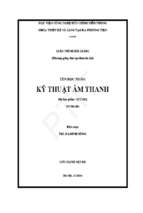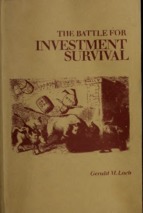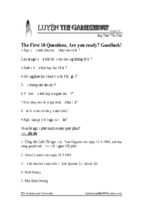The battle for investment survival
THE BATTLE FOR
INVESTMENT
SURVIVAL
Gerald M.Loeb
THE BATTLE FOR
INVESTMENT
SURVIVAL
by Gerald M. Loeb
Fraser Publishing Company
Burlington, Vermont
No part of this book may be reproduced
any manner whatsoever without written permission
All rights reserved.
in
of the publisher except in the case of brief quotations to
be used in critical articles or reviews.
©1935, 1936, 1937, 1943, 1952, 1953, 1954, 1955, 1956,
1957, 1965 BY G.M. LOEB
ORIGINALLY PUBLISHED BY SIMON AND SCHUSTER, INC.
630 FIFTH AVENUE, NEW YORK 20, N.Y.
LIBRARY OF CONGRESS CATALOG CARD NUMBER: 57-12506
MANUFACTURED IN THE UNITED STATES OF AMERICA
NINETEENTH PRINTING
1988 edition published by Fraser Publishing Company,
a division of Fraser Management Associates, Inc.
Box 494, Burlington, Vermont 05402
with permission of Simon & Schuster
2nd Printing, 1990
3rd Printing, 1992
4th Printing, 1993
5th Printing, 1995
Acknowledgments
Some of the articles contained in the following chapters
originally appeared in Barron's, The Commercial and
Financial Chronicle, Investor Magazine, Trust and Estates,
in the NANA syndicated column,
"Wall Street Today." "A Layman Looks at Building" First
appeared in the Architectural Fbrum.
American magazine, and
Don't Sell — People Buy from Me," is from
How I Made the Sale That Did the Mostfor Me, compiled
The chapter "I
and edited by J.M. Hickerson, Prentice-Hall,
Library of Congress Catalog Card
Inc., 1951.
Number: 88-081705
ISBN: 0-87034-084-0
Cover design by S.L. White
Printed in the United States by Braun-Brumfield, Inc.
CONTENTS
Foreword
7
Introduction
9
Requires Knowledge, Experience and Flair
1.
It
2.
Speculative Attitude Essential
17
3.
Is
There an Ideal Investment?
20
4.
Pitfalls for the Inexperienced
23
How to Invest
27
.5.
for Capital Appreciation
13
6.
Speculation
7.
Sound Accounting for Investors
35
8.
Why Commitments Should Not Be Haphazard
38
9.
Some "Don'ts"
41
vs.
Investment
in
32
Security Programs
10.
What to Look for
11.
Concerning Financial Information, Good and
Bad
in
Corporate Reports
44
—and When
12.
What to Buy
13.
Importance of Correct Timing
14.
Statistical Analysis,
52
56
Market Trends, and
Public Psychology
15.
Price
49
59
Movement and Other Market Action
63
Factors
16.
Further Technical Observations
17.
More on Technical
Position cf Market
Interpretation and Significance
68
— Its
75
18.
Advantages of Switching Stocks
80
19.
"Fast Movers" or "Slow Movers"?
83
20.
Detecting "Good" Buying or "Good" Selling
86
4
contents
Qualities of the Good Investor or Investment
Adviser
89
22.
Gaining Profits by Taking Losses
91
23.
You Can't
96
24.
Strategy for Profits
25.
The Ever-Liquid Account
106
26.
A Realistic Appraisal of Bonds
1
27.
Merits of Mining Shares
115
21.
Forecast, but
28. Diversification
You Can Make Money
99
of Investments
10
119
29.
Travel as an Education for Investors
122
30.
General Thoughts on Speculation
125
31.
Investment and Spending
129
32.
Investment and Taxation
133
33.
Investment and Inflation
146
155
Postscript
34.
Case History Examples
35.
Investment Trust Investing
156
Is
Average
168
Investing
Mean
36.
Do Tax
37.
Odd-Lot Investors Aren't Always Wrong
171
38.
What Women Should Know About
173
39. Tip
40.
Losses
169
Savings?
Stocks
to the Investor: Always Write
What
Better: Dollars
the Bush"?
Is
in
It
Down
—or
the Hand
176
"in
178
Contents
41.
5
Last Wills and Testaments Should Be
Carefully Drawn
42. Price
43.
of Stock
Is
180
What Counts
182
Careful Investors Look for Signs of Quality
Management
184
44.
Act Your Age When Investing
45.
Investors Should Budget for Future
186
Fluctuations
188
46.
What to Do About
47.
Several Fallacies of the Marketplace
192
48.
Are You Fast Enough to Switch Capital?
194
49.
How
50.
Losses
190
a Bull Market Affects Your Investment
Thoughts
Don't Let Tax Questions Cloud Investment
198
Decisions
5
1
52.
Stop Orders Need Careful Evaluation
202
Middle Course Helps Buyers to Avoid Market
204
Fallacies
54.
Wall Street Proverbs Are Often Fallacious
55.
Investing in
56.
News and the Market
57.
A
58.
200
Cash Dividends May Slow Growth of Young
Company
53.
196
New
207
Products
Little Investment Knowledge
for Every Citizen
205
209
Is
Necessary
Don't Look for Management at Bargain Rates
211
213
CONTENTS
59.
Miracle Plan Investing
216
60.
The Step System
221
61.
Double Dividends
224
62.
A Layman Looks at Building
233
63.
Investment Manager's Dilemma
241
64.
I
65.
Money from Market Letters
259
66.
The Ideal Client
263
67.
Perpetual Profits
265
68.
What Makes
267
69.
A Dollar Today
70.
The Leopard Never Changes
71.
Words for the Beginner
275
72.
More on Tape Reading
281
73.
What's the Value of Watching "Tape"?
290
74.
Importance of Equity Investments
292
75.
Wallflower Stocks
295
76.
More Double Dividends
298
77.
Never Accept Without Checking
313
78.
How
Don't Sell
—People Buy from Me
a Stock "Good"?
243
269
Its Spots
to Get the Most Out of Your
Investments
270
315
FOREWORD
Remember the old saw:
"Those who can, do. Those who
can't, teach or write success stories."
Without for a moment implying that all teachers and authors
do the things they teach and write about, the
publishers undertook to prove the old adage false by persuading
a successful speculator to revise his book in which he tells how
he does it.
The author is a seasoned stock broker and the material in this
book is distilled from over 40 years of experience in Wall
Street, plus knowledge gained from study of the ups-and-downs
of thousands of brokerage accounts. But, he is not an ivorytower theorist. He has tested his accumulated knowledge in the
hot forge of the market place with millions of dollars of cold
cash. His findings are now available to the readers of this
lack the ability to
book.
Until the stock market debacle of 1929, security-holders
were inclined to accord their invested capital the life-blood of
their economic existence
less attention than they gave to their
automobile or teeth. "Once a good investment, always a good
investment" seemed to be their attitude. But Mr. Loeb sets forth
—
—
the inescapable investment doctrine that eternal vigilance
price of success
and bluntly
states that
is
the
an "ideal investment
is
totally non-existent."
In substance, this
book
is
"hard-boiled," realistic, at times
promises no short cuts to wealth; neither does it
take the "sour grapes" attitude that Wall Street is a snare and
unorthodox.
It
delusion. Rather
it
is
a succinct, straight-forward,
uncompro-
mising revelation of stock market technique and philosophy by
one who has been successful enough to make his views worth
recording.
INTRODUCTION
The publication of
of
The
this up-to-date
Battle for Investment Survival
demand
steady
for the
first
is
and enlarged edition
due to two factors
—
the
hardcover edition, which has sold
over 200,000 copies, and the highly complimentary comments
made by
last
here, practically without change.
1964 tax
of the
cally, the
The
various readers of that edition.
hardcover book, which was
updated
contents of the
in 1957, are included
Here and there, as in the case
have been made. Basi-
revision, text changes
philosophy of the book has withstood the
test of time.
of the chapters were written in 1935 and checked in 1943
Some
and 1957 and again now in 1965; they are still as valid as when
they were written.
This edition, however, contains considerable additional material.
A
reader of one of
you ever
was
my
discussions asked
earlier
tried out the ideas outlined in
to the effect that the ideas
were
your book?"
tried out
first,
— "Have
My
reply
and the book
written afterward.
Any
earner
who
an investor.
cally
earns
It
more than he can spend
is
automati-
doesn't matter in the slightest whether he
wants to be or not, or even whether he realizes that he
is
invest-
ing.
Storing present purchasing power for use in the future is
investing, no matter in what form it's put away. Some popular
and
common forms
include
money
itself,
government bonds,
savings bank deposits, real estate, commodities, securities of
types,
diamonds and where and when
The
real objective of investment
excess current purchasing power
brick
all
invests
it
it's
is
all
legal, gold.
fundamentally to store
for future use.
A man
lays
time he saves $48 and
day and earns $48. Perhaps in
for the future. Some day he may want someone
else to
INTRODUCTION
10
would like to hire a bricklayer at
do a day's work for the $48 he saved. That at least
build a house for him, and he
that time to
is
the ideal situation.
In real
life, it
works a
fluctuates. In later years,
it
The value
may
first
most
cost less, but
more. Thus, just keeping the $48
Since this book was
of
surely will not cost exactly
hire a bricklayer for a day. It
will cost
differently.
little
will
money
$48
likely
to
it
not always do.
written the cost of labor has been
constantly rising.
In fact, attempting to offset inflation, the rising cost of living
or the depreciation of the dollar, however
it
is
labeled, has
become the number one investment consideration.
The average individual will pay storage and insurance for
putting away things he wants to keep for the future. But when it
comes to putting away savings he not only does not expect to
pay, but also he wants others to pay him either interest or
dividends for the use of his savings.
are risks involved of not getting
it
If
all
he
feels as well that there
back, then he wants to be
paid a profit besides, either in the form of a higher rate of
income or a potential capital gain. Altogether, of course, he
expects too much and aims at too little.
All the above boils
down
to the necessity of
measuring the
power rather than dollars. You must get back a sufficient number of additional dollars
to make up for lost purchasing power if prices are rising, and a
high enough percentage of your original dollars if prices are
falling. I put it this way because usually there is some profit
from investments in times of rising prices (but rarely enough),
return from investments in purchasing
and generally there are losses
usually too
When
I
in
times of falling prices, and
many.
started investing about 1921,
it
seemed a peaceful
enough occupation. By 1943, I started calling it a "battle,"
though a lot of people might have used that term much earlier,
during 1929 to 1932. In 1957 it seemed a "war." The hazards
are
still
increasing.
The person who
studies a
problem from every angle and
Introduction
1
defines the risks, aims
is
more than halfway
Believe
it
and
possibilities correctly before
he
starts
to his goal.
some people almost always make money
or not,
in
and far between. It
that most of those who succeed do so within one of
the stock market. Admittedly, they are few
is
my
belief
the patterns described in this
eventually have
is
book.
governed by their
possess, the time they give to
it,
What
success investors
abilities,
the stakes they
the risks they are willing to take
and the market climate in which they operate. I am certain that;
depending upon the degree and the proficiency with which they
are applied, the experiences, ideas, guides, formulas
ciples outlined here
can do no
less
and prin-
than improve the readers'
investment results regardless of what they might do.
As we
said before, almost everything written in earlier edi-
tions for this collection of discussions
am
still is
valid.
However,
I
adding some new ideas which have been tested and found
equally valid, and
some
discussions of the
more complex
influ-
ences that dominate investing today.
Readers of previous editions keep calling attention to what
felt was an inconsistency on the major premise of diversification. There is no inconsistency. Diversification is a necessity
for the beginner. On the other hand, the really great fortunes
were made by concentration. The greater your experience, the
greater your capability for running risks, and the greater your
ability to chart your course yourself, the less you need to dithey
versify.
Gerald M. Loeb
Summer, 1965
1
REQUIRES KNOWLEDGE, EXPERIENCE,
AND FLAIR
IT
Nothing
and
is
more
difficult,
fairly profiting in
learn.
Wall
I
truly believe, than consistently
Street. I
know
of nothing harder to
Schools and textbooks supply only a good theoretical
background. Individuals, partnerships and closed corporations
have scored great successes for themselves
in the
money
know, none with a
in the stock
market, but, as far as
record of uniform success
is
I
handling of
available to the general public.
Into this field the outsider turns for quick and easy profit, or
haven of
a high income, or a
less
thought than most of his
safety.
On
activities,
the average, he gives
and he
is
it
usually care-
whom he deals. Frebetween results obtained by
chance and those secured through knowledge. Often he is
"sold" something instead of buying it on his own decision, and
less as to
whom
quently he
often he
is
fails
he consults or through
to
distinguish
the victim of sharp practice.
Knowledge born from
one
profits; lack of
it is
actual experience
is
the reason one loses.
information and the ability to interpret
it
the answer to
why
Knowledge means
marketwise. But, in
addition, making money in the market demands a lot of "genius" or "flair." No amount of study or practice can make one
successful in the handling of capital if one really is not cut out
for
it.
The engineering student
attends a school and
rules regarding stresses and strains. In later
is
life
taught certain
these rules al-
ways apply. True, there may be several answers to a given
problem, and one man may solve it quicker or in a more ingenious way than another, but an answer based on sound principles always holds.
There
is
no such thing
dozen experts
as a final
will arrive at
answer to security values.
12 different conclusions.
It
A
often
THE BATTLE FOR INVESTMENT SURVIVAL
14
happens that a few moments later each would alter his verdict if
given a chance to reconsider because of a changed condition.
Market values are fixed only in part by balance sheets and
income statements; much more by the hopes and fears of humanity; by greed, ambition, acts of God, invention, financial
stress
and
weather, discovery, fashion and numberless
strain,
other causes impossible to be listed without omission.
Even
figure
moment
the price of a stock at a given
influence in fixing
its
a potent
is
subsequent market value. Thus a low
might frighten holders into
selling, deter
chasers or attract bargainseekers.
A
prospective pur-
high figure has equally
varying effects on subsequent quotations.
Where
is
who can
the institution or individual
How many
cessful investment?
guarantee suc-
can stand on their records?
Who
can show a worthwhile return over a sufficiently long and varied
number
of years in a high proportion of investments with pur-
chasing power maintained and reliable liquidating values always
who
growing? There are those
will step
forward and claim the
something
distinction, but, as in the case of perpetual motion,
will
always be missing.
This, then,
the problem which the
is
often far from a success in his
solve.
A
few minutes
own
"Man on
the Street,"
thinks he easily can
field,
in a broker's office, a visit
from a bond
salesman, a small fee to an "advisory service," and he
something, or letting someone
"profit"
smart
on
man
wants more.
his first transaction,
or
If
is
this
he
loses,
all,
his
He
What do
He has
of the thousand
is
buying
he makes a
is
simple. Naturally he
he loses so quickly that he
fast.
their records?
If
he probably thinks himself a
knows next
usually
broker or dealer or adviser.
business?
in
him something.
certain Wall Street
can recover equally
about
sell
How
is
sure he
nothing
to
long have they been
their balance sheets look like?
only the sketchiest knowledge,
What
if
and one ways they might cause him
any
are
at
to lose
money.
Any way one
ceeding
in
Wall
looks at
it,
Street, yet
equipped people or
is
nothing
nothing
is
is
more
difficult
than suc-
attempted by such poorly
considered as easy.
//
Requires Knowledge, Experience and Flair
This being the case, what can
bright side,
if
we do about
15
it?
What is
What
such a gloomy picture has a bright side?
the
are
the virtues of Wall Street? Is the subject worth studying at
all?
The
principal virtues of Wall Street are its continuous quotaand the comparatively satisfactory liquidity of selected
securities. There is no alternative form of investment, such as,
for example, real estate, which can give the "Man on the Street"
the ease and low cost of purchase and sale, the ready and frequent appraisal, the high liquidity and the protection from fraud
possessed by the active security dealt in an auction market.
Therefore, by all means, don't pass up Wall Street; but try to
tions
make
the best of
it;
realize
its pitfalls;
don't expect the impos-
sible.
There are some rules that hold, and my first is to buy only
is quoted daily and can be bought and sold in an
auction market daily. The greater the volume of trading and the
broader the market in a particular security, the closer to a fair
price at a given moment that security is likely to be. Then, too,
there is a great value in knowing whether one is making or
something that
There
losing.
is
a great value in being able to realize the profit
or cut short the
world
loss.
There
is
the greatest protection in
in the ability to shift capital quickly
and
all
the
at small cost.
Money has been made in securities that are not regularly
Money has been made in securities that at the start, at
any rate, couldn't be resold. But my object is to point out how
quoted.
the greatest risks
nated, and, in
my
and
pitfalls of the
opinion,
if
stock market can be elimi-
the average
man
avoids securities
no ready market, he saves himself from a host
of dangers with which he probably cannot cope. It is more
difficult for the dealer to charge a false price for an actively
quoted security. It is more difficult for him to obtain an abnormal fee or margin of profit. It is more difficult to hide from a
for
which there
client a
is
subsequent loss or
at least
delay
its
discovery.
Without in any way minimizing the hazards, I regard the
listed markets as the best field for the attempted enhancement
or preservation of surplus funds. Therefore, the more one learns
THE BATTLE FOR INVESTMENT SURVIVAL
16
about them, the more chance he has to preserve something. It is
anything else in life. Only a few amass fortunes. Only a few
like
become
really
competent professional
cess in any line of endeavor.
The
men
or achieve real suc-
great majority go about their
daily lives performing their daily tasks, including the humblest,
in far
It
from an
ideal
manner.
remains for each of us to
applies to investment just as
it
strive to
do
better,
and
applies to anything else.
this
The
extent to which one realizes one's distance from perfection
the real measure of
Street.
It
is
how
successful one
the realization of the danger that
"Fools rush in," and in Wall Street that
There
edge
will
Street.
may become
is
in
is
Wall
important.
is fatal.
no line of endeavor in the world where real knowlpay as rich or as quick a monetary reward as Wall
is
SPECULATIVE ATTITUDE ESSENTIAL
People expect too much of investment. They think,
rectly, that they must always keep their money "working."
If
investment were merely what most people think
buying something for income
—
incor-
it is
—
just
fortunes would be extremely
easy to establish by simply letting the
money compound
it-
self.
Capital
compounded
The
6% doubles itself in money value in
5% in little more than fourteen years.
at
only twelve years, and at
fantastic results of this process
Frank A. Vanderlip
in a
were
illustrated
by the
late
Saturday Evening Post story of Janu-
He pointed out that if the rich Medici family in Italy
hundred years ago had set aside at 5% compound interest an investment fund equal to $100,000, its 1933 value would
be $517,100,000,000,000,000 (five hundred and seventeen
quadrillions). The original sum could have been represented by
a globe of gold about nine inches in diameter, and the final
figure would be 46 million times the existing monetary gold
ary, 1933.
just six
stock of the world.
Investment
is
far
more complicated than
value back with interest or at a profit.
When
just getting
money
the prices of things
one buys are going down, the principal danger of loss is selecting a bad risk or paying too much for it. If we were sure prices
would fall, cash itself would become an ideal investment.
But when we fear prices will rise, then the problem becomes
not merely increased, but multiplied. Mr. Vanderlip illustrated
this point in a
dramatic way, too.
He showed
that
if
an investor
had placed $1,000 in a savings bank in 1900 and had allowed it
to accumulate at compound interest, he would have had $2,000
However, according
the investor would have had
in 1920.
to
to
Mr. Vanderlip's calculations,
add from his pocket another
THE BATTLE FOR INVESTMENT SURVIVAL
18
$ 1 ,000 in order to buy exactly as many goods as he could have
purchased during 1900 with the original $1,000 deposit.
That
tal
—
is
the greatest threat to successful preservation of capi-
the varying purchasing
power of money. There
are
many
other threats, such as taxation, regimentation (including rationing), war, new inventions, political changes and revolutions.
The weather and shifts in mass psychology both have very great
effect.
No, the hope of the average investor cannot
realized.
The preservation
something that normally costs a price.
as
in practice
be
upon
as
of capital should be looked
merely incidental to a rental or
It
should not be regarded
profit.
Indeed, should some super-solvent agency agree to preserve
power of capital for a substantial length of time at a
annum, informed people would embrace the plan
enthusiastically if they felt there was any real possibility of the
the buying
stated fee per
agency staying solvent.
The number
of individuals possessed of the necessary
flair
for
combatting the obstacles to successful investment and possessed
of the necessary drive to cultivate this ability through education,
experience and the right connections
portion
similarly
successful
in
is
comparable
other fields
to the pro-
requiring
a
like
background. Really top-flight investors are no more frequent,
proportionately, than capable
Army
generals,
doctors, scientists, lawyers, artists, composers
Some
Navy
admirals,
and musicians.
individuals can invest and speculate sufficiently better than
the average to
show an overall profit. Many who lose only a porpower are, in fact, doing better than most.
tion of their spending
The purpose of this and subsequent chapters is to help the
hardheaded few to make profits, which cannot be done without
the acceptance of the foregoing logic as the
A
first step.
very clear definition of the investor's objective
necessary.
To
is
equally
achieve success, one must set the investment goal
very high. Not only that but the goal must also be a speculative
one, for only there
lies
safety
—paradoxical
The buyer must not merely seek
as that
many seem.
repayment at some future
time of the dollar capital invested. Nor can he concern himself
the
- Xem thêm -





















